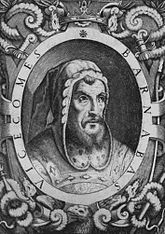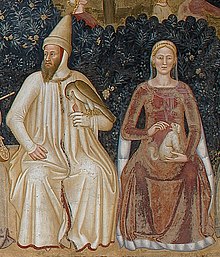Bernabò Visconti
Bernabo Visconti | |
|---|---|
| Lord of Milan | |
 | |
| Coat of arms |  |
| Reign | 1354–1385 |
| Predecessor | Giovanni Visconti (archbishop of Milan) |
| Successor | Gian Galeazzo Visconti |
| Born | 1323 Milan, Italy |
| Died | 19 December 1385 (aged 61–62) Trezzo sull'Adda, Italy |
| Noble family | Visconti |
| Spouse(s) | |
| Issue among others... |
|
| Father | Stefano Visconti |
| Mother | Valentina Doria |
Bernabò or Barnabò Visconti (1323 – 19 December 1385) was an Italian soldier and statesman who was Lord of Milan. Along with his brothers Matteo and Galeazzo II, he inherited the lordship of Milan from his uncle Giovanni. Later in 1355, he and Galeazzo II were rumoured to have murdered their brother Matteo since he endangered the regime.[1][2] When Galeazzo II died, he shared Milan's lordship with his nephew Gian Galeazzo. Bernabò was a ruthless despot toward his subjects and did not hesitate to face emperors and popes, including Pope Urban V. The conflict with the Church caused him several excommunications. On 6 May 1385, his nephew Gian Galeazzo deposed him. Imprisoned in his castle, Trezzo sull'Adda, he died a few months later, presumably from poisoning.[3]
Life
He was born in

In 1356, after having offended the emperor, he pushed back a first attack upon Milan by the imperial vicar
In the spring of 1368 Visconti allied with
In 1373, the pope sent two papal delegates to serve Bernabò and Galeazzo their excommunication papers (consisting of a parchment bearing a leaden seal rolled in a silken cord). Bernabò, infuriated, placed the two papal delegates under arrest and refused their release until they had eaten the parchment, seal, and silken cord which they had served him.[5] He managed to resist, despite also the outbreak of a plague in Milan, whose consequences he suppressed with frantic energy.[6] In 1378 he allied with the Republic of Venice in its War of Chioggia against Genoa. His troops were however defeated in September 1379 in the Val Bisagno.
Bernabò, whose despotism and taxes had enraged the Milanese, is featured among the
Children

Bernabò was an ally of Stephen II, Duke of Bavaria: three of his daughters were married to Stephen's descendants. He had at least 15 legitimate children with his wife Beatrice Regina della Scala:[12]
- Taddea Visconti (1351 – 28 September 1381), married on 13 October 1364 Stephen III, Duke of Bavaria, of the Royal House of Wittelsbach. They had three children including Isabeau of Bavaria, Queen consort of King Charles VI of France of the Royal House of Valois
- Leopold III, Duke of Inner Austria, of the Imperial House of Habsburg, by whom she had six children.
- Marco Visconti (November 1353 – 3 January 1382), Lord of Parma in 1364; married in 1367 Elisabeth of Bavaria, by whom he had one daughter.
- Antonia Visconti (ca. 1354 – 26 March 1405), engaged in 1366 to King Frederick III of Sicily, but he died before the wedding took place; married 27 October 1380 Eberhard III, Count of Württemberg, of the Royal House of Württemberg, by whom she had three sons.
- Lodovico Visconti (1355 – 7 March 1404), Governor and Lord of Parma during 1364–1404 and Governor of Lodi during 1379–1385; married in November 1381 Secondotto, Marquess of Montferrat. They had a son, Giovanni, who possibly left descendants: the family Milano-Visconti, Reichsfreiherren at Utrecht claim descent from him.
- Valentina Visconti (ca. 1357 – bef. September 1393), married in September 1378 King Peter II of Cyprus, of the Royal House of Lusignan, by whom she had one daughter who died in early infancy.
- Carlo Visconti (September 1359 – August 1403), Lord of Cremona, Borgo San Donnino and Parma in 1379; married Beatrice of Armagnac, daughter of John II, Count of Armagnac and Jeanne de Périgord, by whom he had four children.
- Caterina Visconti (1361 – 17 October 1404), married on 2 October 1380 as his second wife, Gian Galeazzo Visconti 1st Duke of Milan, by whom she had two sons, Gian Maria Visconti, 2nd Duke of Milan; and Filippo Maria Visconti, 3rd Duke of Milan, who fathered Bianca Maria Visconti by his mistress Agnese del Maino.
- Agnese Visconti (1362 – 7 February 1391), married 26 September 1380 Francesco I Gonzaga, of the House of Gonzaga, by whom she had one daughter. Agnes was executed for alleged adultery.
- Rodolfo Visconti (ca. 1364 – January 1389), Lord of Bergamo, Soncino and Ghiara d'Adda in 1379. Unmarried.
- Henry XVI of Bavaria.
- Charlotte de Bourbon-La Marche, of the Royal House of Bourbon, by whom he had six children.
- Mastino Visconti (March 1371 – 19 June 1405), Lord of Bergamo, Valcamonica and Ghiaradadda in 1405; married in 1385 Cleofa della Scala, by whom he had three children.
- Elisabetta Visconti (1374 – 2 February 1432), married on 26 January 1395 Ernest, Duke of Bavaria, by whom she had five children including Albert III, Duke of Bavaria.
- Lucia Visconti (ca. 1380 – 14 April 1424), married firstly on 28 June 1399 Frederick of Thuringia (future Elector of Saxony) but the union was dissolved on grounds of non-consummation shortly after; married secondly on 24 January 1407 Edmund Holland, 4th Earl of Kent. No issue.
His illegitimate offspring by Donnina del Porri, legitimated in a ceremony after the death of his wife in 1384,[a] were as follows:
- Palamede (d. 1402).
- Lancellotto (d. after 1413).
- Sovrana, married Giovanni de Prato.
- Ginevra, married Leonardo Malaspina, Marchese di Gragnola (d. 1441).
In addition, Bernabò had other illegitimate offspring by other mistresses:[14]
—With Beltramola Grassi:
- Ambrogio (1343 – killed in battle Caprino Bergamasco, 17 August 1373), condottiero and Governor of Pavia.
- Enrica (born ca. 1344), married Franchino Rusconi dei Signori di Como.
- Margherita (ca. 1345 – d. after 1413), Abbess of the Convent of Santa Margherita.
- Ettore (ca. 1346 – 1413), who briefly took the Lordship of Milan (16 May – 12 June 1412), married Margherita Infrascati.
—With Montanina de Lazzari:
- Sagramoro (d. 1385), Lord of Brignano (1380), married Achiletta Marliani, this branch finish with two Ladies: Claudia Visconti of Brignano, married in 1581 to Lodovico Marazzani Landi, Lord of Paderna and Villa del Riglio, Lord of Castelnuovo and Fabiano, from 1602 Lodovico Marazzani Landi Visconti Lord of Paderna, from 1605 Lodovico Count Marazzani Landi Visconti, Count of Paderna and Villa del Riglio, ect., and Flerida Visconti of Brignano married with Alessandro Marazzani Landi, Lord of Paderna and Villa del Riglio and one Lord: Alessandro Visconti, Lord of Brignano, Doctor in Laws in Pavia University
- Donnina (1360–1406), married in 1377 to Sir John Hawkwood.
—With Beltameda Cassa:
- Elisabetta [Isotta] (d. 1388), married in 1378 to Count Lutz I von Landau, leader of the "Grand Company" of Condottiere in Italy.
—With Giovannola Montebretto:
- Bernarda (d. 1376), married Giovanni Suardi.
—With Caterina Freganeschi:
- Galeotto (d. after 1413).
- Riccarda, married Bernardon de la Salle.
—With unknown mistresses:
- Lionello (d. after 1404).
- Isabella.
- Damigella.
- Isotta, married (annulled 1382) Carlo Fogliani.
- Daughter, married Bernardo della Sala, Lord Soriano nel Cimino.
- Valentina (d. after 10 April 1414), married Antonio Visconti, Lord of Belgioioso.
Ancestry
| Ancestors of Bernabò Visconti | ||||||||||||||||||||||||||||||||||||||||||||||||||||||||||||||||||||||||||||||||||||||||||||||||||||||||||||||||||||||||||||||||||||||||||||||||||||||||||||||||||||||||||||||||||||||||||||||||||||||||||||||||||||||||||||||||||||||||||||||||||||||||||||||||||||||||||||||||||||||||||||||||||||||||||||||||||||||||||||||||||||||||||||||||||||||||||||||||||||||||||||||||||||||||||||||||||||||||||||||||||||||||||||||||||||||||||||||||||||||||||||||||||||||||||||||||||||||||||||||||||||||||||||||||||||||||||||||||||||||||||||||||||||||||||||||||||||||||||||||||||||||||||||||||||||||||||||||||
|---|---|---|---|---|---|---|---|---|---|---|---|---|---|---|---|---|---|---|---|---|---|---|---|---|---|---|---|---|---|---|---|---|---|---|---|---|---|---|---|---|---|---|---|---|---|---|---|---|---|---|---|---|---|---|---|---|---|---|---|---|---|---|---|---|---|---|---|---|---|---|---|---|---|---|---|---|---|---|---|---|---|---|---|---|---|---|---|---|---|---|---|---|---|---|---|---|---|---|---|---|---|---|---|---|---|---|---|---|---|---|---|---|---|---|---|---|---|---|---|---|---|---|---|---|---|---|---|---|---|---|---|---|---|---|---|---|---|---|---|---|---|---|---|---|---|---|---|---|---|---|---|---|---|---|---|---|---|---|---|---|---|---|---|---|---|---|---|---|---|---|---|---|---|---|---|---|---|---|---|---|---|---|---|---|---|---|---|---|---|---|---|---|---|---|---|---|---|---|---|---|---|---|---|---|---|---|---|---|---|---|---|---|---|---|---|---|---|---|---|---|---|---|---|---|---|---|---|---|---|---|---|---|---|---|---|---|---|---|---|---|---|---|---|---|---|---|---|---|---|---|---|---|---|---|---|---|---|---|---|---|---|---|---|---|---|---|---|---|---|---|---|---|---|---|---|---|---|---|---|---|---|---|---|---|---|---|---|---|---|---|---|---|---|---|---|---|---|---|---|---|---|---|---|---|---|---|---|---|---|---|---|---|---|---|---|---|---|---|---|---|---|---|---|---|---|---|---|---|---|---|---|---|---|---|---|---|---|---|---|---|---|---|---|---|---|---|---|---|---|---|---|---|---|---|---|---|---|---|---|---|---|---|---|---|---|---|---|---|---|---|---|---|---|---|---|---|---|---|---|---|---|---|---|---|---|---|---|---|---|---|---|---|---|---|---|---|---|---|---|---|---|---|---|---|---|---|---|---|---|---|---|---|---|---|---|---|---|---|---|---|---|---|---|---|---|---|---|---|---|---|---|---|---|---|---|---|---|---|---|---|---|---|---|---|---|---|---|---|---|---|---|---|---|---|---|---|---|---|---|---|---|---|---|---|---|---|---|---|---|---|---|---|---|---|---|---|---|---|---|---|---|---|---|---|---|---|---|---|---|---|---|---|---|---|---|---|---|---|---|---|---|---|---|---|---|---|---|---|---|---|---|---|---|---|---|---|---|---|---|---|---|---|---|---|---|---|---|---|---|---|---|---|---|---|---|---|---|---|---|---|---|---|---|---|---|---|---|---|---|---|---|---|---|---|---|---|---|---|---|---|---|---|---|---|---|---|---|---|---|---|---|---|---|---|---|---|---|---|---|---|---|---|---|---|---|---|---|---|---|---|---|---|
| ||||||||||||||||||||||||||||||||||||||||||||||||||||||||||||||||||||||||||||||||||||||||||||||||||||||||||||||||||||||||||||||||||||||||||||||||||||||||||||||||||||||||||||||||||||||||||||||||||||||||||||||||||||||||||||||||||||||||||||||||||||||||||||||||||||||||||||||||||||||||||||||||||||||||||||||||||||||||||||||||||||||||||||||||||||||||||||||||||||||||||||||||||||||||||||||||||||||||||||||||||||||||||||||||||||||||||||||||||||||||||||||||||||||||||||||||||||||||||||||||||||||||||||||||||||||||||||||||||||||||||||||||||||||||||||||||||||||||||||||||||||||||||||||||||||||||||||||||
Footnotes
References
Citations
- ^ ISBN 9780241972977.
- ^ a b Black (2009), p. 52.
- ^ Black (2009), pp. 52–53.
- ^ George L. Williams, Papal Genealogy: The Families and Descendants of the Popes, (McFarland and Company Inc., 1998), 34.
- ISBN 0-552-11681-5; p 147, although here it says the incident occurred in 1370.
- ^ For his plague regulations for Milan, see Rosemary Horrox, The Black Death(1994) III.65, p 203.
- ^ Chaucer had been sent to Lombardy in 1378 on behalf of the young King Richard II to seek the support of Bernabò and Sir John Hawkwood on behalf of the English war effort against France. His epistola metrica III.29 was tacitly addressed to Bernabò (Ernest H. Wilkings, The 'Epistolae Metricae' of Petrarch, (Edizioni di Storia e Letteratura), p. 11).
- ^ Muir (1924), p. 86.
- ^ Black (2009), p. 53.
- OCLC 231957454.
- OCLC 884276067.
- ^ Bueno de Mesquita (1941), Table II. The descendants of Bernabò Visconti.
- ^ H.S. Ettlinger, "Visibilis et Invisibilis: The Mistress in Italian Renaissance Court Society", Renaissance Quarterly, 1994.
- ^ Mauro Colombo, Gian Luca Lapini, Matteo Sormani Turconi, Guido Maria Ratti. "I Visconti — Storia di Milano". www.storiadimilano.it (in Italian). Retrieved 10 September 2020.
{{cite web}}: CS1 maint: multiple names: authors list (link)
Sources
- Black, Jane (2009). Absolutism in Renaissance Milan. Plenitude of power under the Visconti and the Sforza 1329–1535. Oxford: Oxford University Press. ISBN 9780199565290.
- Bueno de Mesquita, Daniel Meredith (1941). Giangaleazzo Visconti, Duke of Milan (1351-1402): a study in the political career of an Italian despot. Cambridge: Cambridge University Press. OCLC 837985673.
- Muir, Dorothy Erskine (1924). A history of Milan under the Visconti. London: Methuen & Co. Ltd.
External links
- Biography (in Italian)

